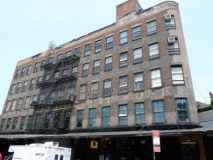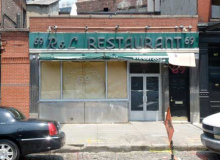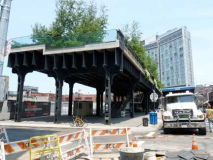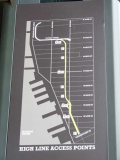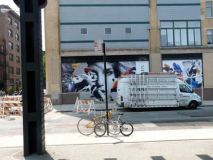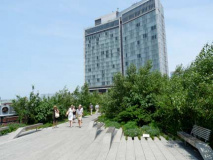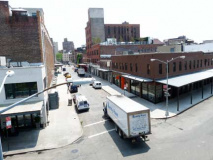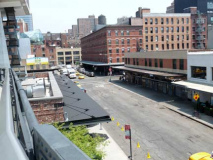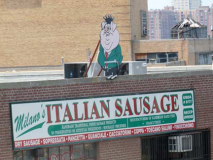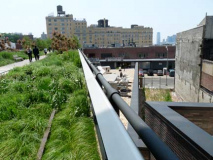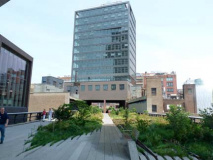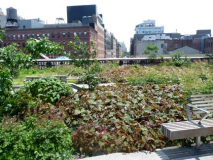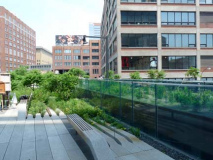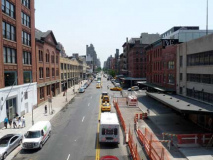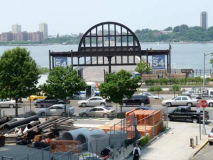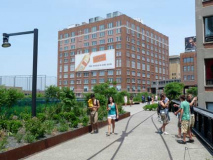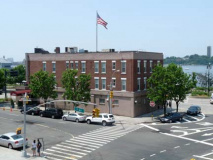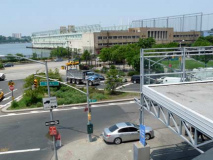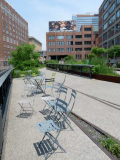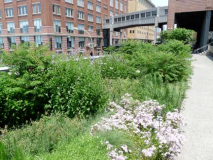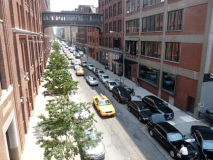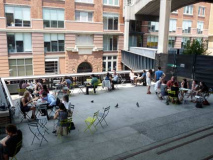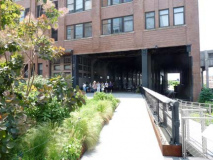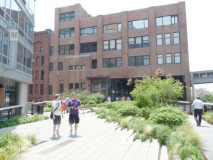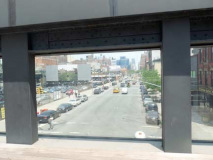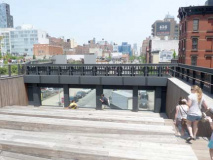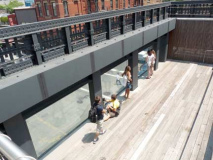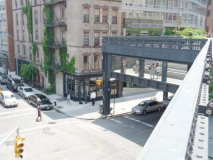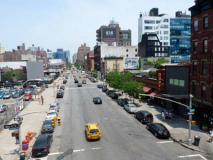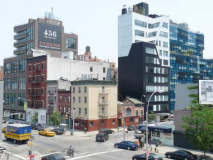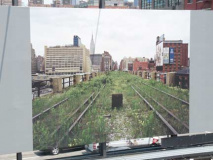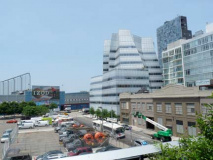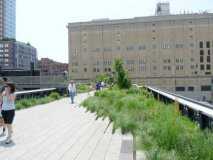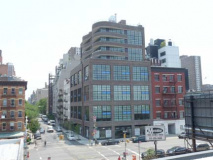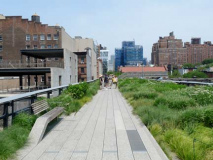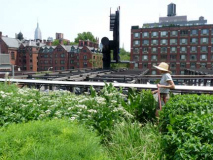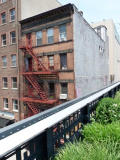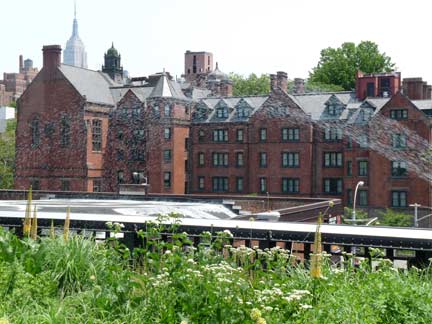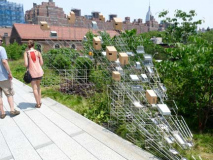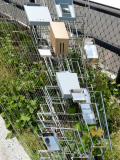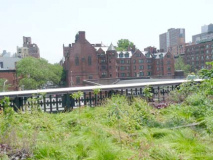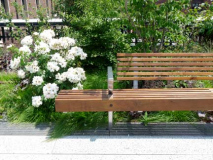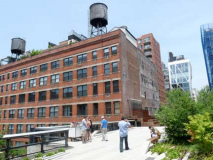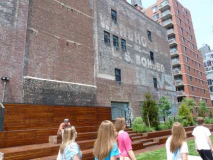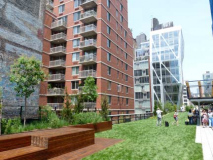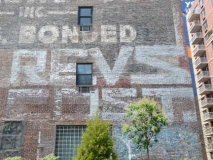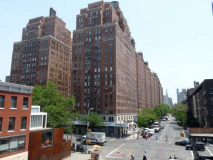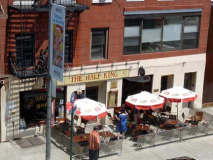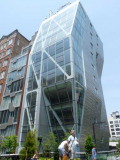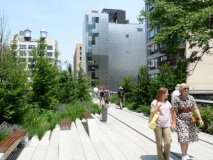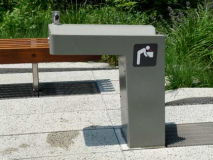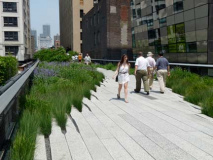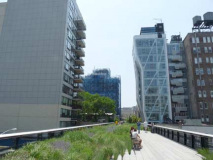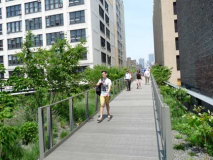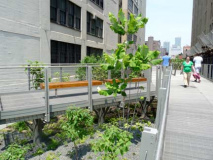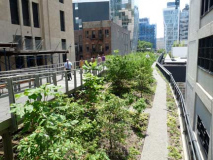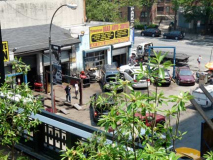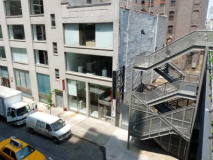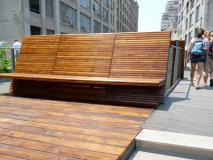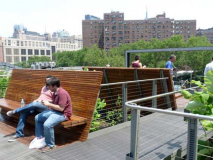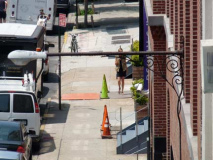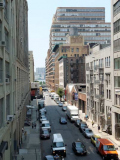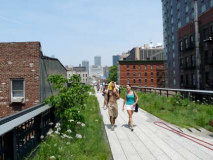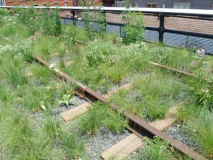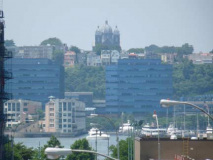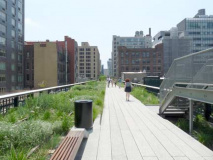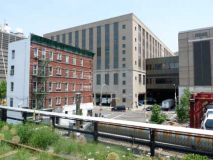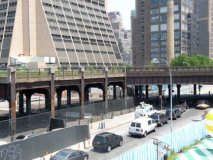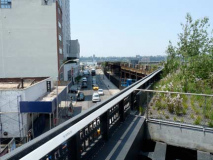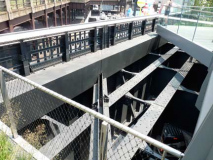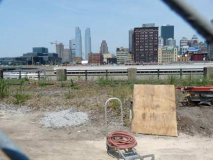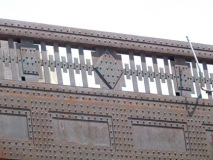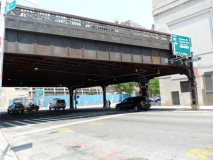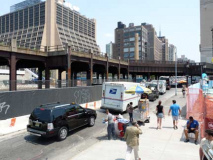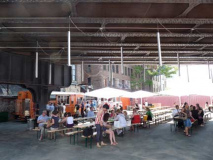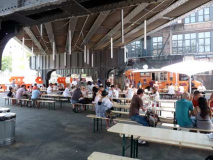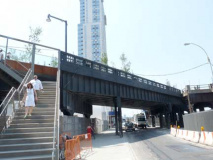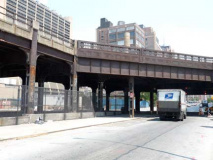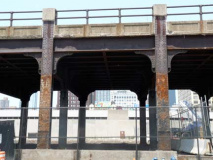New York City opened up a second section of its only major rail to trails project, the former West Side Freight Railroad (popularly called the High Line) in June 2011 from West 20th to West 30th Street, leaving only a short section from West 30th to West 34th undeveloped. The city does hope to open that remaining section during the coming decade. I’ve already chronicled the opening of the lower section, between Gansevoort Street and West 20th, in June 2009 — but couldn’t resist walking the entire route this time. (It provides context, and got me out on a gorgoeous day.)
The former freight railroad, inactive since 1980, went through a number of revitalization plans, including one that would have placed light rail on it, before it was redesigned as a high-concept public park with money raised in great part by donations to the friends of the High Line organization. The revitalization (or gentrification) of the Meatpacking District, which found fashion models and 24-hour party people neighboring with meat wholesalers of the Far West Side, was another impetus to the project. New York has been remarkably resistant to rails to trails projects, with a number of opportunities around town such as the old Long Island Rail Road Rockaway Branch and Staten Island Rapid Transit North Shore Branch. The difference with the High Line, is of course, money and celebrity, as the West Side of Manhattan has seen multi-million dollar high rise condominium complexes rising in tandem with the High Line’s development (Try that in Rego Park, Queens or Port Richmond, Staten Island!)
The politics aside, the High Line is a wondrous NYC achievement, designed by the Diller, Scofido + Renfro architecural firm with innovative landscaping by James Corner that partly preserves the old railroad legacy of the viaduct, but also retains its more latterday incarnation of an abandoned structure recaptured by nature. Plants, flowers and vegetation shares the walkway with ballast and rail installations that hark back to when this was a working railroad.
Before accessing the High Line at Gansevoort and Washington Streets, I took note of a pair of highlights on Gansevoort itself: the New England Biscuit Works Building and the R&L Restaurant, which, in its most popular incarnation between 1985 and 2008, was operated as a French bistro and diner by French immigrant Florent Morellet.
The Biscuit Works Building, which still faintly announces its old occupation in faded letters on its exterior, apparently occupied two flors of the building from 1890-1892; the building itself went up in 1887, according to painted sign expert Walter Grutchfield. Entrepreneur Elmer Burnham, whose faded at for beef wine can still be seen on the side of the building, also occupied space here from 1897-1929. He was a producer of clam bullion, but also an odd tonic consisting of beef bouillon, wine and iron, hence the sign.
Florent, which was open 24 hours a day, could be seen as a great place for lunch (which is how I thought of it) but also a place where local artists, clubgoers, flamboyant gay activists, politicians and celebrities would go to see and be seen. Nevertheless, the menu remained varied and affordable. Since the rent was raised too high for Morellet to continue on, other bistros, some blatant copiers of Florent’s esthetic, have attempted to fill the space without success.
New York’s hallmark, like most major cities, is that it always looks forward and rarely looks back. TheHigh Line succeeds at both.
The corner of Gansevoort and Washington ( being dug up by Con Ed workers on 6/8/11, the day I was here) was for decades occupied by a meat wholesaler in a building located under the trestle, which itself has been cut back from a longer el that extended south to Bank Street, going through several buildings along the way: the buildings either made way for the railroad, or were built around it. Today, there’s a clean, neat, unadorned metal staircase to the elevated. A route map shows the present park in yellow, with the hoped-for acquisition of the rest of the el in white.
At present the High Line in its southern stretch is a place where there are a few meat wholesalers such asDeBragga and Spitler still plugging away adjacent to high rises such as The Standard. The wholesalers, who had been in business in what will always be called the Meatpacking District, had been here for over a century, but are gradually succumbing to high rents and prices, which do not faze The Standard’s customers.
Little West 12th Street (left) and Washington Street. The sidewalks are covered with awnings left over from the time when the streets were mostly occupied with meat wholesalers and light manufacturers. If you look at photos of the old Washington Market south of here (Danny Lyon lovingly detailed them just before their demolition to make way for Independence Plaza in his book The Destruction of Lower Manhattan), those streets had similar awnings, which are still found along Greenwich Street between Hubert and Canal. My question is, what particular advantage do they convey?
In any case, boutique and restaurant owners have cleverly kept the awnings, which provide good shade in the summer.
Milano’s, which imports Italian sausage (many Italian sausage retailers display the “animal cannibal” image of a pig holding a string of sausages, or otherwide gloating; we imagine they’re oblivious pigs to the slaughter) and Weichsel Beef (which also distributes pork) are two more of the old guard still remaining.
High Line architects have retained its old railings in most spots (which have varying styles) and installed a safety fence inside.
450 west 14th Street, known as 450W14 or simply The High Line Building, which was in its infancy in 2009 when I previously passed through, is nearly complete; it was built atop one of the buildings that bridged over the High Line. It is an office building designed by architect Morris Adjmi and consists of a 10-story glass tower on top of a much older brick building.
Some of the much-admired vegetation so prevalent in the new High Line landscaping. I’m no botanist so feel free to comment on what these are, exactly.
In 2011, I am 54 years old in August (why bother concealing such things, except to prospective employers?) and so, I can remember the very odd entrances and exits to the old Miller (West Side) Highway, which actually brought traffic to the center of the roadway, forcing a tricky maneuver to avoid traffic flow. The High Line was built in the early 1930s as a companion structure to the Miller, and wittingly or unwittingly, some of the pedestrian steps to enter and exit pay tribute to the Miller’s old arrangement by bringing foot traffic to the center of the walkway.
A look east on the very busy 14th Street.
At 14th Street going north you catch sight of the Chelsea Market complex, which runs between 9th and 11th Avenues from West 15th to west 16thStreet. These buildings formerly belonged to the National Biscuit Company (the first Oreo cookie was made here in 1912). Some of the complex between 9th and 10th is open to the public as the Shops at Chelsea Market, and it’s an evocative, warts and all experience as the gourmet shops are presented in architecture that seems unchanged for decades. The upper floors house television studios.
Looking west from 14th, the giant iron gate that passengers once passed through to enter Pier 54 has been retained. A close look at the iron work will reveal a White Line/Cunard palimpsest. The RMS Carpathia deposited survivors of the Titanic disaster to Pier 54 in April, 1912.
Liberty Inn, at the triangle at West 14th and 10th and 11th Avenues. This longtime hot sheets joint, billed on its website as “your rendezvous for romance” has so far resisted gentrification. In 2009, travel site Oyster offered a peek inside.
The Liberty Inn, designed by Richard R. Davis, was built in 1908 for poultry dealers, the Conron Brothers. Originally known as the Strand Hotel, it accommodated sailors from the nearby piers. When the Titanic survivors were brought to these piers, the New York Times used the hotel as a headquarters. Other uses have included a boarding house, speakeasy, night club, and restaurant. Its many alterations reflect the changes in the Gansevoort area from shipbuilding to meatpacking to night-life hot spot, and it stands out within the area as one of the few buildings still retaining its original use, that of a hotel. Historic Preservation Studio
Pier 57, just north of West 14th on what is officially called Joe DiMaggio Highway (though Joltin’ Joe is rarely evoked here, a la the Robert F. Kennedy or Edward I. Koch Bridges) was built on floating concrete caissons in the Hudson River in 1952. This was the detention center where over 1800 protesters at the 2004 Republican National Convention were taken to after arrest in August/September 2004. Because of unsafe conditions, many suffered burns and other maladies and successfully sued the NYPD for damages.
The Titanic was booked to port nearby and never made it, but nevertheless, here are some deck chairs. How does the High Line maintain unfettered chairs and tables? Like Bryant Park does: the honor system.
Some more abundant verdancy on the High Line.
The High Line consists of many turns and angles, no more so than the ramps that now lead to nowhere but formerly went into adjoning buildings as it crosses 10th Avenue. Note the handsome foot bridge that connects buildings on either side of West 15th Street.
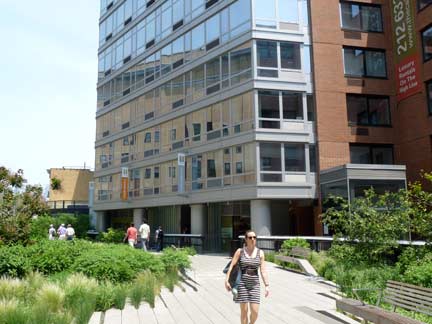
The Caledonia, at West 17th Street, bills itself as the first luxury condo built along the High Line. Curbed offers a look inside.
Whenever something is named Caledonia, expect some connection to Scotland, as that was the Roman name for it. It is used an euphemism for Scotland in poetry, much like “Columbia” for the USA or “Albion” for England.

In some spots along the High Line one section is elevated above the other. The situation was taken advantage of by High Line designers to create the somewhat unwieldly named Diller-Von Furstenberg Sundeck, which provides a spray of water on hot days. The deck is named for prominent High Line donors, media mogul Barry Diller and fashion giantess Diane Von Furstenberg, who are husband and wife.

A look at one of the ramps that connected the High Line to the National Biscuit Company. It’s now a curated green space off limits to walkers.
Showing the High Line walkway passing through the Chelsea Market/National Biscuit complex.
At West 17th street the High Line takes a turn to the northwest, crossing the avenue and then running just west of 10th north to West 30th. One of the most popular and beloved features of the new High Line park is this ‘observation deck’ suspended above the intersection. Parkgoers can then people- and traffic-watch from the deck, while motorists and pedestrians on the surface seem to see them as an ever-shifting motion picture. The wood seats do get warm in the direct sun.

The 1900-era building at the corner of 10th Avenue and west 17th street was formerly home to Red Rock West (1995-2008), which copied the still-extant Hogs and Heifers with its coterie of sexy barmaids. It’s now a tamer pizza place.
At West 17th the High Line juts out to provide some sitting space. The view directly ahead is of an ever changing billboard that in June 2011 was providing a view of the High Line in its idle days from 1980-2009, weed choked and silent. The photo shows an eastbound stretch along west 30th with the King of All buildings in view.
Looking ahead to the right along 10th Avenue and East 18th we can see 447 West 18th, the blue and silver Chelsea Modern building (2009, Audrey Matlock) and neighboring black and silver 459 West 18th (Della Valle Bernheimer).
And, look to the left for the IDC Building, conceived by frank Gehry to look like a sailing vessel. The buiding houses Barry Diller’s media enterprise. This was Gehry’s first major NYC project. The Chelsea pier sports complex on West Street is also seen.
The question of whether it’s a fashionably decked-out yacht trying to hitchhike up the West Side Highway, a majestic schooner of misted glass hoisting the flag of Diller’s Internet empire, or some eerie urban ship lost in the fog is quickly forgotten once inside. Unlike most of Gehry’s work, this building actually looks better on the inside. That’s not to say that the interior looks better than the exterior, but everywhere you go in this glass house of offices the exterior is on display. The workers inside get the best view of IAC’s lines and surfaces. There are the odd angles of glass that curve tantalizingly back into view of work spaces, surfaces that easily and deliberately mix the building’s silhouette with reflected images of the city. There’s the nighttime view, which is already pretty spectacular from outside; but from inside, the mixing of the pointillist lights of Manhattan with the colorful brilliance of the interior puts each worker inside an ever-changing sculpture of glass and light. –John Hockenberry, Metropolis, 6/20/07
One of the many just-the-basics High Line staircases, this one at West 18th. It supports the big bilboard.
Though it faces 10th Avenue this new curved-front residential building on the corner is 456 West 19th (2010, Carey Tamarkin). Curbed provides views for most of us who can’t afford it.
The High Line trail continues north past gardens as the General Theological Seminary complex comes into view. Occasionally, the elevated passes close to older residential buildings.
The General Theological Seminary (highlighted by the gardeners’ hose) occupies almost the entire block between West 20th and West 21st Streets and 9th and 10th Avenues. The complex contains buildings constructed between 1836 and 1900, and boasts a Harvard or (closer to home) Brooklyn College-like quadrangle. Famed author Clement Clarke Moore (1779-1863) donated the land on which it stands.
This is the first of a number of art installations I found while making my way north. They were installed in June 2011 and will be in place through June 2012. These birdhouse-like installations are by Sarah Sze and are called Still Life With Landscape (Model for a Habitat).
Church of the Guardian Angel, 193 10th Avenue at West 21st Street, once again across from the General Theological Seminary. The parish originated on West 23rd Street in 1888. The original church had to be torn down in the early 1930s to make way for the West Side Elevated Freight Railroad — today known as High Line Park, which we’re on at the present. The New York Central Railroad, therefore, funded this new Sicilian Romanesque church that was completed in 1930. Lavish bas reliefs on the 10th Avenue side depict the life of Christ.
The church and the seminary as seen from the Fields of the High Line. What flowers are those next to the bench?
Now approaching West 22nd Street. The side streets from here north are lined with warehouses peppered with art galleries and the occasional art gallery. There are also auto repair shops, some of whose landlords are trying to evict them and attract more expensive tenants.
Between West 22nd and 23rd is a high wood bench and the High Line’s only extended public grassy area. Early reports related that couples were, ah, getting jiggy with it on the grass after sunset, but those reports are unconfirmed.
On the high brick wall facing the el is one of the last large remaining “Revs vs Cost” tags. Dating from the early 1990s they were the work of Revs (whose real name remains a mystery) and Adam Cost (Adam Cole). Since those years Revs has moved on to wrought iron installations, and Cost left the graffiti game after a 1995 arrest. The city has apparently been trying to eradicate this ‘affront’ to the sensibilities of High Line strollers, but, along with the auto repair shops, it’s one of the few elements of the old 10th Avenue still easily discernible. The tag is overprinted above a ‘legitimate’ sign advertising the warehouses.
One of my favorite apartment complexes, London Terrace, can be seen from the High Line. It takes up the entire block between West 23rd, West 24th, 9th and 10th Avenues. The complex, built in 1930, consists of over 1600 apartments; considered the largest apartment complex in the world when completed. The units surround a private garden. One bedrooms are in the $3,000s.
HL23 at 515 West 23rd is a residential tower completed by architect Neil Denari in 2010. Hard to tell from this angle but the tower bows out on the top 4 floors to stretch over the High Line. Author Sebastian Jünger’s Half King Restaurant is on the near side of the elevated on the right.
Looming up ahead is 245 10th Avenue (2009 Della Valle Bernheimer). It’s asymmetrically windowed with apparently some apartments getting a side window, some not. I spotted a piano through one of the windows. People will have to be careful walking around in the apartments, since High Line patrons can readily see inside. Curbed noted: “written into the building’s bylaws is a standing $10,000 annual donation to Friends of the High Line.”
Among the High Line’s more notable additions are talking water fountains. Like the Sarah Sze birdhouse installation, these are temporary exhibits and will be in place for a year from June 2011-June 2012.
Julianne Swartz‘s sound installation, Digital Empathy, greets High Line visitors with a variety of messages. At some sites, computer-generated voices speak messages of concern, support, and love, intermingled with pragmatic information. In other sites, those same digitized voices recite poetry and sing love songs to park visitors.
Installed in 11 different locations throughout the park, the sound is transmitted through the park’s bathroom sinks, water fountains, and elevators. These sites are not only unexpected places in which to encounter public art, they are places designed for individuals or small numbers of people, allowing for intimate encounters within an otherwise sprawling, communal space. The locations for Swartz’s sound interventions are indicated by graphic-based signage created by the artist that mimics standard public information signs.
Digital Empathy plays on the notion that, in our culture, we turn to technologies like online social networking, blogs, and instant messages to meet our basic human need for friendship and personal connection. Friends of the High Line
Looking north and south on the High Line from about west 24th Street.
The High Line is on two levels between East 25th-26th Streets at the Philip A. and Lisa Maria Falcone Flyover.
This steel catwalk, named after the donors Philip A. and Lisa Maria Falcone, will take people eight feet up above the High Line from 25th Street to 26th Street … moving them through a canopy of magnolia trees and between two tall warehouse buildings, with glimpses of a hidden smokestack and passageways to the west. “You have these buildings pressing up against you and you’re in this Manhattan canyon,” Ricardo Scofidio, one of the architects, said. The High Line under the flyover will be covered with moss and shade groundcover. The magnolias will create an ethereal quality. “These are very strange trees,” Mr. Corner said. “They’re leggy, they reach for the light, they have very big leaves, and they’re very surreal.” NY Times
A spur at West 26th Street features a wood bench for parkgoers to take a break before heading up the home stretch. An empty metal frame echoes a billboard that was once mounted here. The bench overlooks the Firestone Bear Auto Center, which seems to be considered an eyesore form High Line and real estate developers, who will likely make sure it is gone before too long.
A look down the side streets provides a view of the curved-edged, multi-windowed Starrett-Lehigh Building (West 27th) and a remaining ornate Type G cast iron wall lamp (West 25th).
Above West 27th is a walk through a wildflower field, rendered with a reisntalled railroad track. I used my zoom lens to focus toward the Monastery of St. Michael the Archangel in Union City NJ, seen from West 29th. (When I worked on west 29th for a few years I’d see this far -off apparition and wonder what it was.)
The Monastery and Church of Saint Michael the Archangel is a state and national historic place in Union City, New Jersey. Formally opened in 1869 and completed in 1875, the grounds of the complex are bounded West Street and Summit Avenue between 18th and 21st Streets. The small street leading to its front entrance from the east is called Monastery Place. At one time the largest Roman Catholic church in Hudson County, it has since became home to a Presbyterian congregation while part of the grounds are used for housing and education. wikipedia
At its northern end the High Line allows views of the giant Morgan Post Office processing facility. In the summer of 2011 a kiddie park was set up in an open plaza at 10th Avenue and West 30th Street.
The northern end of High Line Park overlooks the remaining undeveloped portion of the elevated line in its ‘raw’ unvarnished state. The city eventually hopes to acquire this section and develop it to its northern end at West 34th Street near the Javits Center, as well as the spur that crosses 10th Avenue to the Morgan facility. The giant Silver Towers can be seen in the distance.
More views of the High Line’s undeveloped portion. In the open space at West 30th Street, food trucks and benches have been set up, perhaps temporarily before a permanent facility is built on the site.


